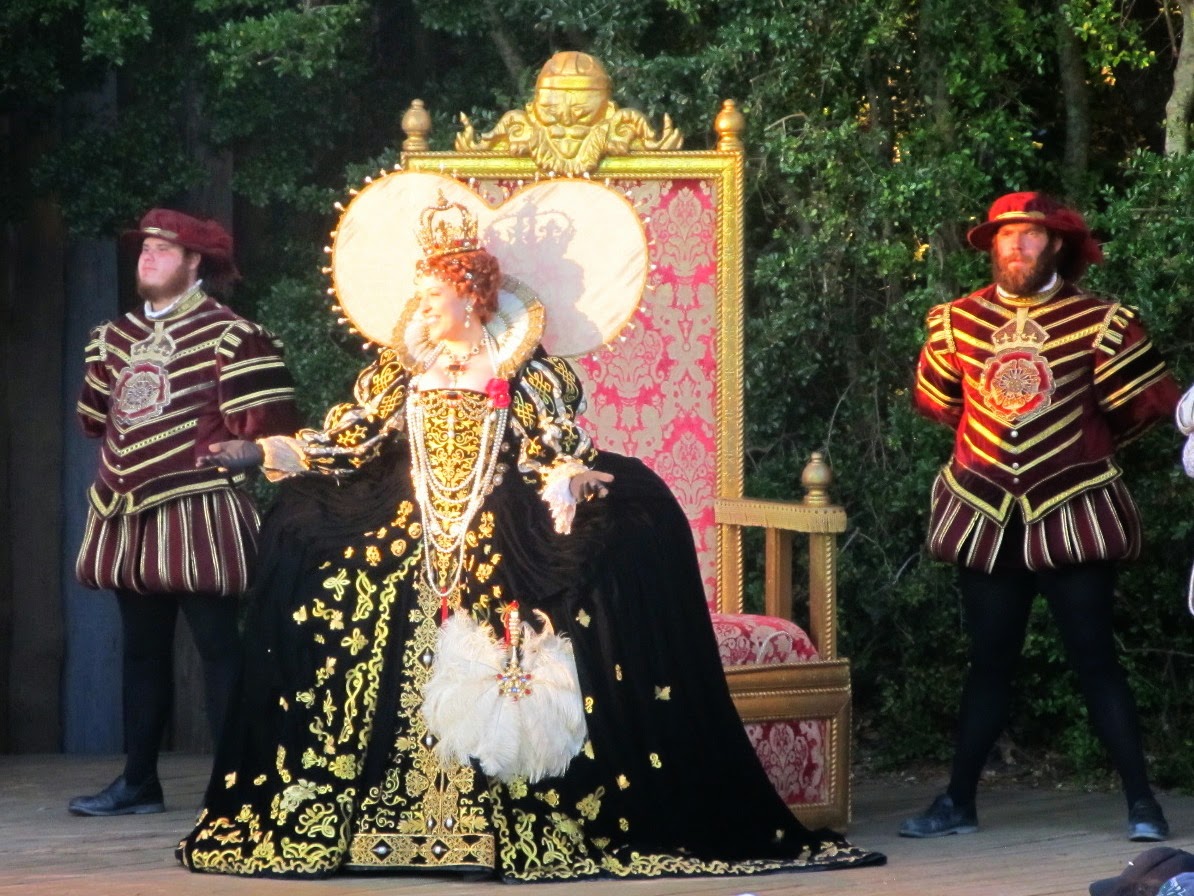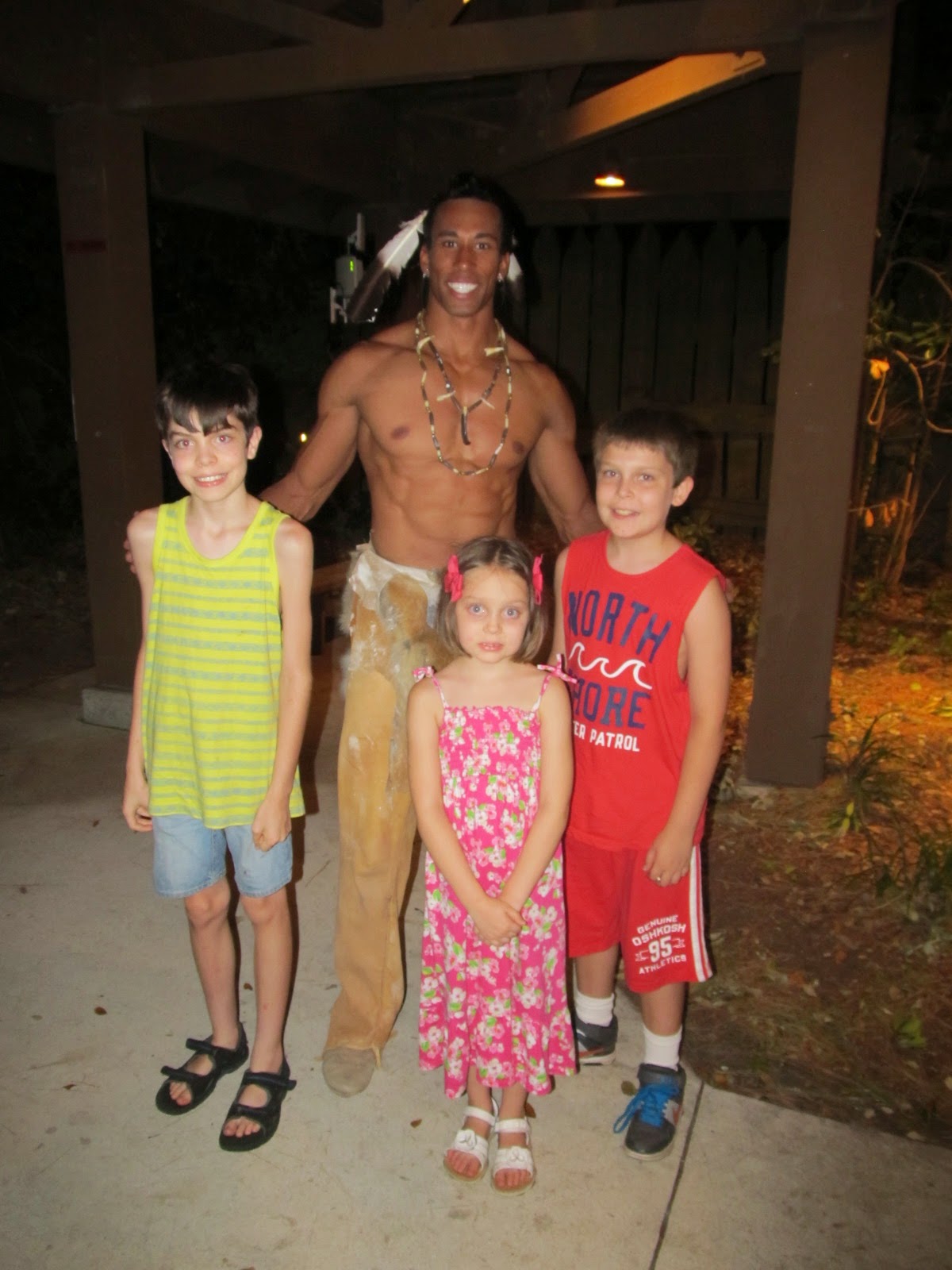So now I can scratch-off the item that topped my 2014 Summer Bucket List: taking the kids to see The Lost Colony in Manteo. This Tony-winning outdoor drama has been running since 1937 and it is PHENOMENAL!!! Tim and I saw it years ago before we had children, and I have been dying to bring the kids to see it. The play was even better than I remembered...
The Lost Colony performance has anything you'd want in a good play: there is a fantastic script (family friendly), numerous fight scenes that the boys liked between the colonists and the natives, and beautiful singing and dancing that Anna liked. In preparation for going to the play, the five of us have been reading-up on the Roanoke Colony, and we can attest that the storyline of the play runs historically accurate with everything we've read about the event.If you aren't familiar with the story of The Lost Colony, let me give you the Reader's Digest version. In an attempt to plant the first English colony in what would become America, in 1587 Sir Walter Raleigh dispatched 115 colonists - including women and children - to "the New World." Joy resounded when a little girl named Virginia Dare was born weeks after the boat landed. But the colonists had all kinds of trouble and ran out of supplies, so they sent the governor (Virginia Dare's grandfather) John White back to England for help. Because England was by then at war with Spain, John White could not return to the colony for three years. When he arrived back to Roanoke Island, the colony had disappeared. Except for a few artifacts, there were no people, no bodies, and all the houses and buildings were gone. The word "CROATOAN" were carved on one tree and the letters "CRO" carved on another. The colonists were never seen again, and what happened to them is the first and one of the greatest mysteries in American history.
Possible theories of what happened to the colonists:
- The Spanish attacked the colony and killed the colonists. The Spanish were, after all, at war with the English, and the Spanish wanted the New World for themselves.
- Indians massacred the colonists or turned them into slaves. Preceding English explorers had several run-ins with the Indians and at one point killed a beloved Indian chief. Years after the Lost Colonists disappeared, explorer John Smith (of Pocahontas fame) would meet a Native American Chief who claimed that his tribe killed the Lost Colonists.
- The colonists died in a hurricane.
- The colonists died of starvation. They landed in North Carolina during the worst drought in 800 years.
- The colonists died of disease, such as what happened to many of the Plymouth pilgrims.
- When it took so long for John White to return to the colony, the colonists joined a local band of friendly Indians. Later in history, several tribes of Indians (including the Lumbee of Eastern North Carolina) would claim to be descendants of the Lost Colonists who had inter-married with their Indian ancestors.
- The colonists simply moved to another location...hence the writing on the tree. A nearby island was at that time called Croatoan, and is now modern-day Cape Hatteras. Nonetheless, Hatteras is not considered large enough to support a colony, and there is no evidence that the colonists were ever there.
The play's costumes were done by six-time Tony Award winning Production Designer William Ivey Long, who has designed costumes for countless Broadway plays. All the costumes are amazing, but none compare to those of Queen Elizabeth...
One of the reasons I enjoyed taking my children to see The Lost Colony is because it allowed them to actually see history in real life. The actress who portrayed Queen Elizabeth and all of her ladies in waiting swooshed and swirled around the stages effortlessly, even though they were wearing huge costumes that were made of heavy fabrics and constructed with wire. Watching the queen talk and move and sit and stand on stage just seems so much more interesting than when you see a portrait of her in a book. And as I told the kids, "That's how those women dressed every single day. Can you imagine???"
One of my favorite parts of the play had to be the ship that moved back and forth behind the stage to replicate the colonists leaving England and being dropped-off in America. The outdoor theatre is built right up against the Pamlico Sound, so the ship actually looks as if it is floating on the water that is behind the stage. I had to remind myself from time to time that the "ship" is just a prop, and there's not really a ship there.
After the play was over, though, our cool experience was not. Mondays are "Children's Night" for the production, and the kids are allowed to come meet some of the actors and have their pictures taken with them. I was thrilled to get a good look at those costumes up close! Below, Christopher and John pose with the character who played Ananias Dare. He even let the boys hold his sword. Both boys said it was pretty heavy...
Tim posed for a picture with the actor who played Father Martin. A preacher standing with a man pretending to be a preacher. Ha!
The kids also met the the actors who played Sir Walter Raleigh and the narrator, who is supposed to be a modern-day minister. As we talked with the actors we discovered that they had come from all over the country to spend the summer in Manteo doing this play. Some are performing arts majors in college, while others are professional actors.
We also had the opportunity to explore the Visitor's Center that is right beside the theater. There are some cool artifacts and lots of information there. There's a room that is decorated exactly like Sir Walter Raleigh's study would have been, and hanging on the walls are prints of drawings that John White did during his time in the New World.
Portraits of Queen Elizabeth and Sir Walter Raleigh:

This was my favorite piece of information in the Visitor's Center. I look forward to meeting Manteo someday.
So Why Do I love This Play So Much???
Not just because of the gorgeous costumes, the thought-provoking script, the special effects, or the ambiance of the outdoor theater. Perhaps the reason I am so drawn to the story of The Lost Colony is because I can relate to those colonists who left their families whom they greatly love and deeply miss to follow the Lord's will, joyfully faced uncertainty and discomfort, clung to their spouses and children and prayed unceasingly for God to guide them and protect them and tell them where to be. Until that elusive time would finally come when they could stop traveling, that elusive place would be discovered where they could grow roots, and that elusive day would dawn when they could say those word about which
they had been dreaming...
We've found our home.
-Hebrews 11:8-10
"Keep on looking ahead
Let your hearts not forget
We are not home yet."
-Steven Curtis Chapman



















Just beautiful!
ReplyDeleteWe love the story you told of the Lost Colony. We also love seeing you all in the pictures. Kara, you and Tim look so happy in the photo.
ReplyDeleteThanks Kathy. We are happy... God has great things in store for us!!!
Delete